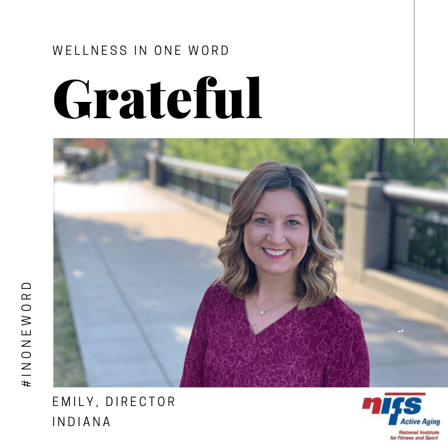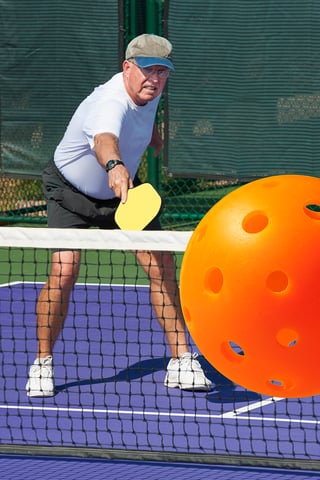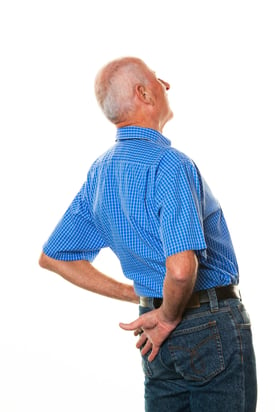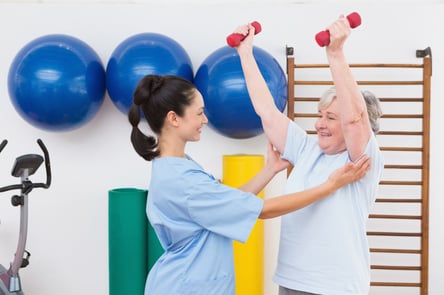NIFS is participating in the Wellness in One Word campaign sponsored by Monarch Collaborations and the International Council on Active Aging (ICAA). The campaign will launch a digital photo gallery during Active Aging Week on October 1 – October 7, 2019 of individuals taking a picture or selfie while holding up their defined word of what wellness means to them in that moment. The goal is to collect and share 1,000 pictures to connect people, spark discussion and create a strong sense of community amongst participants across the world.
It is fascinating to think how this “word” can change for us so many times throughout the day depending on life’s stressors, our interactions with others, what we are able to accomplish in that day, etc.. It’s also interesting how this “word” might be felt or interpreted by different generations.
 When I asked our NIFS team members to share their “word”, I received submissions of vitality, fulfillment, longevity, power, and balance. Our staff join our team from all walks of life and personal and professional experiences, yet their commonality is a strong desire and passion to work with seniors. Through providing individualized exercise services and teaching a variety of exercise classes, our staff are building relationships and helping improve the quality of life for older adults across the country. The tone and context of their submissions was similarly unified.
When I asked our NIFS team members to share their “word”, I received submissions of vitality, fulfillment, longevity, power, and balance. Our staff join our team from all walks of life and personal and professional experiences, yet their commonality is a strong desire and passion to work with seniors. Through providing individualized exercise services and teaching a variety of exercise classes, our staff are building relationships and helping improve the quality of life for older adults across the country. The tone and context of their submissions was similarly unified.
When I first started my career with NIFS, I managed a fitness program for a senior living client on the south side of Indianapolis. During my time at the community, I enjoyed sharing personal milestones with the residents of purchasing our first home, celebrating our first wedding anniversary, becoming pregnant with our first child and receiving a job promotion. As a young professional in that environment surrounded by active older adults with so many stories to tell about their own life experiences and rich histories, it helped me gain a strong perspective in how much one should truly cherish those milestones and experiences. While my job was to teach and lead the residents in various fitness programs, I learned so much from them in this perspective that I have carried with me through my career and life.
We can reflect on the emotional highs and lows of a given day or a given hour of a day when our words might be anxious, happy, excited, or accomplished. When it comes down to focusing on our overall well-being and pursuing a life of purpose and intention, I believe the “words” our staff are feeling transcend all generations whether you are a young professional at 23 beginning your career or an 83-year-old taking a balance class in a senior living community. The NIFS team is learning valuable lessons in how to appreciate those universal truths for all of us pursuing vitality, fulfillment, longevity, and balance. As I personally reflect on this campaign, our teams’ work serving older adults across the country, and what my “word” will be, I chose grateful.
Follow us on Facebook to see some of our Wellness in One Word submissions.

 Pickleball
Pickleball
 I am a firm believer in massage therapy because a little over a year ago, I woke up in agonizing lower-back pain that did not allow me to move. My first thought was maybe I should go see a chiropractor. I had been to one before, but was not the biggest fan because they cracked my back and sent me on my way after charging $65.
I am a firm believer in massage therapy because a little over a year ago, I woke up in agonizing lower-back pain that did not allow me to move. My first thought was maybe I should go see a chiropractor. I had been to one before, but was not the biggest fan because they cracked my back and sent me on my way after charging $65. 
 Sometimes I visit a community and they have a wellness director who is an RN with primary responsibilities for running the community’s outpatient clinic and helping residents navigate their health care needs. In other cases, I interact with an individual at the community level whose title is wellness director, but whose primary roles are focused on running the fitness program. Those two individuals have two very different focus areas, diverse areas of expertise, and they offer two entirely different value propositions for prospective residents. And neither of them paints a full picture of what community wellness can be.
Sometimes I visit a community and they have a wellness director who is an RN with primary responsibilities for running the community’s outpatient clinic and helping residents navigate their health care needs. In other cases, I interact with an individual at the community level whose title is wellness director, but whose primary roles are focused on running the fitness program. Those two individuals have two very different focus areas, diverse areas of expertise, and they offer two entirely different value propositions for prospective residents. And neither of them paints a full picture of what community wellness can be.